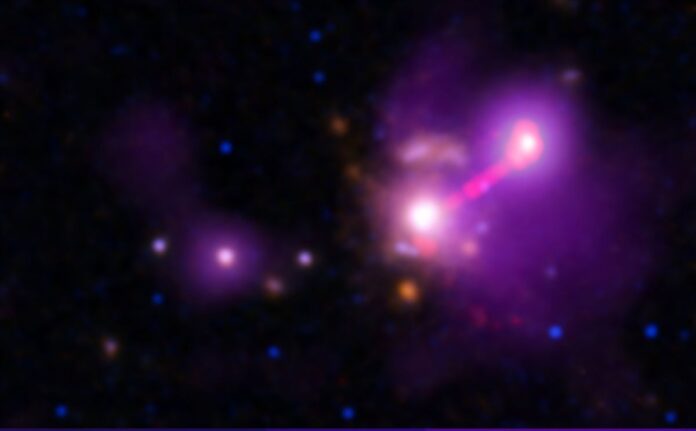A distant galaxy is alone because it devoured the other galaxies that once surrounded it, a new study suggests.
Galaxy 3C 297 floats in the void on its own, about 9.2 billion light-years from Earth, but it wasn’t always that way. New observations by NASA’s Chandra X-ray Observatory and the International Gemini Observatory have revealed that 3C 297 has all the characteristics of a galaxy cluster — except, importantly, the other galaxies. These missing galaxies apparently merged with each other and with 3C 297, the largest out of them with the most gravitational pull, until it was the only one left, researchers found.
“We expected to see at least a dozen galaxies about the size of the Milky Way, yet we see only one,” study leader Valentina Missaglia, of the University of Torino in Italy, said in a statement (opens in new tab).
Related: Amazing Photos by NASA’s Chandra X-Ray Observatory
3C 297 is now being referred to as a “fossil group” because it appears to be the final phase of a merger involving multiple galaxies that were once part of a cluster. It is also the most distant fossil group ever discovered. Missaglia and her research team saw that this solo body of stars behaves like a group in several ways. For example, it is shrouded in clouds of scorching gas that are tens of millions of degrees — not the norm for a lone galaxy, but common for a cluster.
Another sign that 3C 297 is the ghost of a cluster is the behavior of the quasar that is its active galactic nucleus (AGN). Quasars are intensely bright AGNs. These supermassive black holes eat dust and gas pulled in by their extreme gravity, then blast out gargantuan jets of fast-moving material. This quasar’s jet generated powerful X-ray emissions about 140,000 light-years away, suggesting that it interacted with gas surrounding 3C 297 — an indication of a former cluster, study team members said.
But wait. If 3C 297 is so lonely, why does it look relatively close to 19 other galaxies? That was what an image from the Gemini Observatory showed, but it turned out to be something of an optical illusion, because when the distances of those galaxies from the loner were measured, none were close enough for cluster status.
There are still intriguing unanswered questions about 3C 297. For example, astronomers are seeing the galaxy as it looked 9.2 billion years ago. That’s earlier than any other known fossil group, and it’s unclear how the system could have evolved this way in such a relatively short time frame.
“It may be challenging to explain how the universe can create this system only 4.6 billion years after the Big Bang,” study co-author Mischa Schirmer, of the Max Planck Institute for Astronomy, said in the same statement. “This doesn’t break our ideas of cosmology, but it begins to push the limits on how quickly both galaxies and galaxy clusters must have formed.”
The study was published in December 2022 in The Astrophysical Journal (opens in new tab).
Follow us on Twitter @Spacedotcom (opens in new tab) and on Facebook (opens in new tab).

